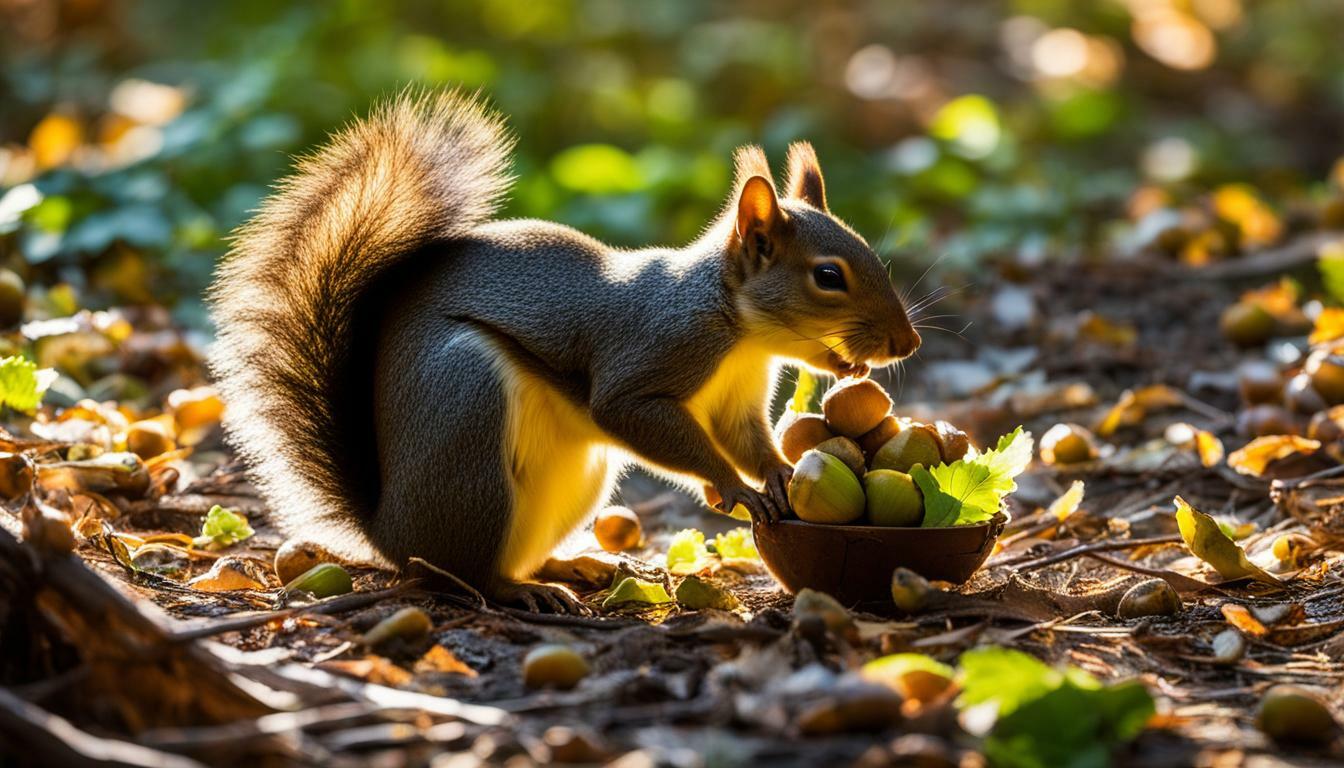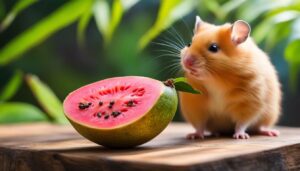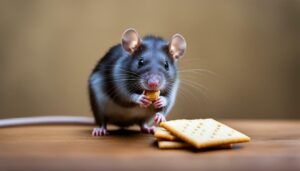Squirrels are notorious for their love of acorns, but do they eat green ones as well? In this section, we will explore the dietary habits of squirrels and uncover the truth about their affinity for acorns.
Key Takeaways:
- Squirrels do eat green acorns, despite the common belief that they are toxic.
- Green acorns may cause a negative mood shift in squirrels due to their higher tannin content.
- Squirrels prefer white oak acorns over red oak acorns due to their lower tannin levels and higher nutritional value.
- They tend to eat white oak acorns immediately and bury red oak acorns for later consumption.
- In addition to acorns, squirrels also eat other nuts, seeds, berries, and insects.
Squirrel Diet: Exploring Their Feeding Habits
To understand squirrels’ appetite for green acorns, let’s take a closer look at their overall diet and feeding habits. Squirrels are opportunistic eaters, and their diet consists of a variety of foods depending on their habitat and seasonal availability. While acorns are a significant part of their diet, they consume other types of nuts, seeds, berries, and even insects.
Squirrels have an innate preference for white oak acorns over other varieties. This is due to the lower tannin levels found in white oak acorns, making them more palatable and nutritious. Tannins are naturally occurring compounds in plants that can have a bitter taste. Red oak acorns, on the other hand, have higher tannin levels, which may be less appealing to squirrels but are still consumed. Squirrels tend to eat white oak acorns immediately and bury red oak acorns for later consumption, utilizing a strategy to maximize their food resources.
In addition to acorns, squirrels also consume a wide range of other foods. Nuts such as walnuts, hazelnuts, and pecans are common in their diet. They also enjoy seeds from various plants, including sunflower seeds and pine cones. Berries like blackberries, raspberries, and strawberries are a sweet treat for squirrels, especially during the fruiting season. Additionally, squirrels have been observed to eat insects like beetles, caterpillars, and even bird eggs when available. This diverse diet allows squirrels to adapt to different environments and ensure they have enough nutrients to thrive.
| Common Foods in a Squirrel’s Diet | Examples |
|---|---|
| Nuts | Walnuts, hazelnuts, pecans |
| Seeds | Sunflower seeds, pine cones |
| Berries | Blackberries, raspberries, strawberries |
| Insects | Beetles, caterpillars, bird eggs |
Acorns play a crucial role in a squirrel’s diet, particularly during the winter months. Squirrels have a remarkable ability to store acorns for future consumption, creating a food stash that sustains them when food sources are scarce. This behavior ensures their survival and minimizes competition with other animals. The abundance and nutritional value of acorns make them a preferred food source for squirrels, highlighting their importance in the overall feeding habits of these charismatic creatures.
Acorns as Squirrel Food: Nutritional Value and Attraction
Acorns play a crucial role in a squirrel’s diet due to their nutritional value and irresistible allure. Despite the common belief that green acorns are toxic to squirrels, these furry creatures do in fact consume them. Green acorns may cause a negative mood shift for squirrels due to the extra tannins they contain, but they are not poisonous.
Squirrels have a preference for white oak acorns over other varieties. This is because white oak acorns have lower levels of tannins and are more nutritious compared to red oak acorns. The abundance and nutritional value of acorns make them a preferred food source for squirrels.
In addition to acorns, squirrels also eat a variety of nuts, seeds, berries, and even insects. Their varied diet ensures they receive a balanced nutritional intake. However, it is the acorns that truly stand out as a staple food for squirrels.
Table: Nutritional Value of Acorns
| Component | Nutritional Value |
|---|---|
| Protein | High |
| Fat | Moderate |
| Carbohydrates | High |
| Vitamins | Rich in Vitamin E |
| Minerals | Good source of calcium, phosphorus, and potassium |
The nutritional value of acorns is evident from the table above. They are high in protein, carbohydrates, and contain a moderate amount of fat. Acorns also provide a rich source of vitamin E and are a good source of minerals such as calcium, phosphorus, and potassium.
Burying acorns is a survival strategy adopted by squirrels. By storing acorns for the winter, squirrels ensure they have a stable food source when food becomes scarce. Burying acorns also helps them avoid competition with other animals, as they can retrieve their buried stash when needed.
The Truth About Green Acorns: Are They Toxic?
Despite popular belief, green acorns are not toxic to squirrels, but they do have some interesting effects on these critters. Green acorns contain higher levels of tannins, a type of bitter-tasting compound that can affect a squirrel’s mood. While squirrels may still consume green acorns, the higher tannin content may cause a temporary mood shift.
It is important to note that squirrels have a preference for white oak acorns over red oak acorns. White oak acorns have lower tannin levels and are more nutritious compared to their red oak counterparts. Squirrels tend to eat white oak acorns right away, as they are more palatable and provide immediate nourishment. On the other hand, they bury red oak acorns for later consumption, as the tannins in red oak acorns are not as desirable.
Squirrels have a varied diet beyond acorns. They also consume other types of nuts, seeds, berries, and even insects. However, acorns are a preferred food source for squirrels due to their abundance and nutritional value. Squirrels have adapted a survival strategy of burying acorns for the winter, allowing them to store food and avoid competition with other animals.
Table: Comparison of White Oak Acorns and Red Oak Acorns
| Acorn Type | Tannin Levels | Nutritional Value |
|---|---|---|
| White Oak Acorns | Lower | Higher |
| Red Oak Acorns | Higher | Lower |
In summary, squirrels do eat green acorns, but they are not toxic. The higher tannin content in green acorns may affect a squirrel’s mood, but it does not pose any significant harm. Squirrels prefer white oak acorns due to their lower tannin levels and higher nutritional value. However, they still consume red oak acorns by burying them for later use. Acorns, along with other foods like nuts, seeds, berries, and insects, play a significant role in a squirrel’s diet and survival.
Preference for White Oak Acorns: Lower Tannin Levels and Nutritional Superiority
Squirrels have a discerning palate when it comes to acorns, and their preference lies with the delectable white oak variety. These resourceful creatures have developed a keen instinct for identifying the most nutritious and flavorful acorns, and they have found that white oak acorns fit the bill perfectly.
What sets white oak acorns apart from their red oak counterparts is their lower tannin levels. Tannins are organic compounds found in plants that can have a bitter taste and inhibit nutrient absorption. White oak acorns contain significantly fewer tannins, making them more palatable and easier for squirrels to digest.
But taste isn’t the only reason why squirrels favor white oak acorns. These acorns also boast a higher nutritional value compared to red oak acorns. Packed with essential nutrients like protein, fiber, and fats, white oak acorns provide a well-rounded and energy-rich meal for these agile climbers.
Table: A Comparison of White Oak and Red Oak Acorns
| Acorn Type | Tannin Levels | Nutritional Value |
|---|---|---|
| White Oak | Lower | Higher |
| Red Oak | Higher | Lower |
The preference for white oak acorns is evident in the behavior of squirrels. They tend to consume these acorns immediately, relishing their delicious taste and reaping the nutritional benefits. On the other hand, red oak acorns are often buried by squirrels for later consumption, as if squirrels are saving them for when they are needed the most.
Squirrels’ affinity for white oak acorns showcases their ability to make smart dietary choices based on taste and nutritional content. As they forage through the vast canopies of oak trees, these acorns provide a vital food source that sustains them and supports their survival, especially during the harsh winter months. So, next time you spot a squirrel munching on an acorn, remember that it’s likely indulging in the creamy goodness of a white oak acorn, a true delight for these furry creatures.
Immediate Consumption vs. Burying for Later: Squirrel’s Acorn Strategy
Squirrels have a cunning strategy when it comes to acorns, with some being savored instantly and others stashed away for later. These clever critters prefer white oak acorns, as they have lower tannin levels and offer higher nutritional value compared to red oak acorns. When coming across a tasty white oak acorn, squirrels waste no time in devouring it right on the spot.
But what about the red oak acorns? Well, squirrels have a different approach for these. Due to their higher tannin content, red oak acorns can cause a negative mood shift for squirrels. However, rather than discarding them, squirrels bury these acorns in various locations, creating a hidden stash for later consumption.
This burying behavior is part of a squirrel’s survival strategy, especially during the harsh winter months when other food sources may become scarce. By burying red oak acorns, squirrels create a winter food stash, ensuring they have enough to eat when resources are limited. This strategy also helps them avoid competition with other animals, as squirrels can recover their buried acorns when needed.
| Squirrel’s Acorn Strategy | White Oak Acorns | Red Oak Acorns |
|---|---|---|
| Immediate Consumption | Savored instantly | – |
| Burying for Later | – | Stashed away |
It’s fascinating to observe how squirrels navigate their way through acorn territory, carefully deciding whether to indulge in the present or save for the future. While they have a preference for white oak acorns due to their lower tannin levels and superior nutritional value, squirrels understand the importance of storing red oak acorns to secure their food supply during lean times. So, next time you spot a squirrel munching on an acorn, remember the intricate strategy behind their acorn selection!
Other Foods in a Squirrel’s Menu: Nuts, Seeds, Berries, and Insects
Although squirrels have a special fondness for acorns, their culinary repertoire extends to an array of other tempting treats. These resourceful critters have a diverse diet that includes nuts, seeds, berries, and even insects.
When it comes to nuts, squirrels are known to feast on a variety of options. They can be seen munching on walnuts, pecans, hazelnuts, and almonds. These crunchy delights provide a good source of energy and protein for the squirrels, allowing them to stay agile and active.
In addition to nuts, squirrels also enjoy a selection of seeds. Sunflower seeds are a particular favorite, as are pumpkin seeds and sesame seeds. These small but mighty snacks pack a punch in terms of nutrition, supplying squirrels with essential fatty acids and vitamins.
Not content with just nuts and seeds, squirrels also have a sweet tooth for berries. Whether they’re indulging in juicy strawberries, raspberries, or blueberries, these fruits offer a refreshing burst of flavor and a dose of antioxidants to keep the squirrels healthy and satisfied.
| Food | Taste | Nutritional Benefits |
|---|---|---|
| Nuts | Crunchy and satisfying | High in energy and protein |
| Seeds | Small and flavorful | Rich in essential fatty acids and vitamins |
| Berries | Juicy and refreshing | Provide antioxidants and other nutrients |
| Insects | Protein-packed and crunchy | Offer a valuable source of animal protein |
Insects also make their way onto the squirrel’s menu. Squirrels have been known to snack on insects such as grasshoppers, beetles, and caterpillars. These small creatures provide a protein-packed feast and add some extra crunch to the squirrels’ diet.
In summary, while acorns hold a special place in a squirrel’s heart, they are just one part of a varied diet. Squirrels also enjoy indulging in nuts, seeds, berries, and even insects. This diverse selection of food ensures that squirrels have access to a range of essential nutrients to keep them healthy and thriving in their natural habitats.
Acorns and Survival: The Winter Food Stash
Burying acorns is not just a quirky behavior; it is a survival strategy for squirrels to navigate the harsh winters and thrive. As the temperatures drop, squirrels instinctively collect and store acorns in hidden locations, forming a vital food stash that sustains them during the colder months.
Squirrels are diligent gatherers, hoarding hundreds, and even thousands, of acorns in preparation for winter. This behavior is known as caching, and it serves multiple purposes. Firstly, by burying acorns in various locations, squirrels minimize the risk of losing their entire food supply to predators or theft.
Secondly, caching allows squirrels to avoid competition with other animals. By spreading out their acorn stash, squirrels can reduce the likelihood of encountering other hungry creatures, such as birds or deer, who would otherwise compete for the same food sources.
| Types of Acorns | Tannin Levels | Nutritional Value |
|---|---|---|
| White Oak Acorns | Lower | Higher |
| Red Oak Acorns | Higher | Lower |
Acorns are a crucial component of a squirrel’s winter diet due to their abundance and nutritional value. A table comparing the tannin levels and nutritional value of white oak acorns versus red oak acorns can be found above. Squirrels have a preference for white oak acorns, as they contain lower levels of tannins and provide higher nutritional benefits. This preference is reflected in their caching habits, with squirrels often consuming white oak acorns immediately and burying red oak acorns for later consumption.
In conclusion, the act of burying acorns is a vital survival strategy for squirrels, ensuring they have a steady food supply throughout the winter. By caching acorns, squirrels protect their food from predators, avoid competition, and take advantage of the nutritional benefits that acorns offer. So, the next time you see a squirrel burying an acorn in your backyard, remember that what may seem like a simple act is actually a crucial part of their survival plan.
The Role of Acorns in Squirrel’s Mood: Tannins and Mood Shifts
As delicious as acorns are to squirrels, the tannins they contain can have an interesting effect on their overall mood. While squirrels are known to consume acorns as a significant part of their diet, the higher tannin content in green acorns may lead to a negative mood shift.
Tannins are naturally occurring compounds found in various plant foods, including acorns. These compounds can affect the taste and texture of acorns, making them bitter and astringent. When squirrels consume acorns with higher tannin levels, it can induce temporary discomfort and distress. This may result in a change in behavior and mood, although it does not pose any toxic risks to squirrels’ health.
Despite the potential mood shift, squirrels still consume green acorns. However, they do have a preference for white oak acorns over red oak acorns. White oak acorns have lower levels of tannins, making them more palatable and nutritious for squirrels. Squirrels tend to eat white oak acorns immediately, enjoying their tasty and nourishing benefits.
In contrast, red oak acorns, which have higher tannin content, are often buried by squirrels for later consumption. By burying the acorns, squirrels utilize a survival strategy to store food for the winter when other food sources may be scarce. This behavior allows them to maintain a reliable food stash and avoid competition with other animals.
| Acorn Types | Tannin Levels | Squirrel Behavior |
|---|---|---|
| Green acorns | Higher tannin levels | Potential negative mood shift but still consumed |
| White oak acorns | Lower tannin levels | Preferred and eaten immediately |
| Red oak acorns | Higher tannin levels | Buried for later consumption |
While acorns play a significant role in a squirrel’s diet, it’s essential to remember that they are not the only food source. Squirrels also consume various nuts, seeds, berries, and even insects. However, the abundance and nutritional value of acorns make them highly attractive to squirrels, contributing to their overall well-being and survival.
Conclusion
Squirrels have a varied diet, with acorns being a significant part of their food intake. Green acorns, despite common belief, are not toxic to squirrels. However, due to their higher tannin levels, they may cause a negative mood shift for these furry creatures. Regardless, squirrels show a preference for white oak acorns, which have lower tannin levels and higher nutritional value compared to red oak acorns.
Interestingly, squirrels have developed a clever strategy when it comes to handling acorns. They tend to consume white oak acorns immediately, enjoying their delicious taste and abundant nutrients. On the other hand, red oak acorns are often buried for later consumption, serving as a vital winter food stash.
While acorns are a staple in a squirrel’s diet, it’s important to note that they also consume other types of nuts, seeds, berries, and even insects. However, the abundance and nutritional value of acorns make them a preferred food source for these agile climbers.
The behavior of burying acorns serves multiple purposes for squirrels. Not only does it provide them with a winter food reserve, but it also allows them to avoid competition with other animals in times of scarcity. This strategy showcases the remarkable adaptability and survival instincts of our bushy-tailed friends.
FAQ
Do squirrels eat green acorns?
Yes, squirrels do eat green acorns. Despite the common belief that they are poisonous, green acorns are not toxic to squirrels. However, they may cause a negative mood shift due to the extra tannins they contain.
What do squirrels prefer, white oak acorns or red oak acorns?
Squirrels prefer white oak acorns. They have lower levels of tannins and are more nutritious compared to red oak acorns. Squirrels tend to eat white oak acorns immediately and bury red oak acorns for later consumption.
What other foods do squirrels eat?
In addition to acorns, squirrels also eat nuts, seeds, berries, and insects. They have a varied diet and adapt to the food sources available in their habitat.
Why do squirrels bury acorns?
Burying acorns is a survival strategy for squirrels. It allows them to store food for the winter when food may be scarce. Burying also helps them avoid competition with other animals for food.




